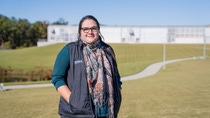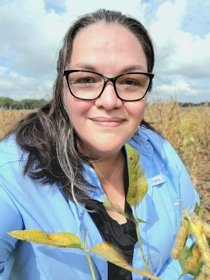Media
The power of biotechnology to improve soybean production

Born and raised in Panama, Marianela Rodriguez-Carres comes from a family of agronomers and farmers, and it’s no coincidence that she chose to pursue studies in plant pathology. She joined BASF in 2012, where she now works as Global Research & Development (R&D) Lead for Soybean and Regional R&D Director for Seeds.
In her current role, Marianela is responsible for aligning BASF's soybean research pipeline with regional needs and overseeing the development of new soybean products, including a novel nematode-resistant trait, NemasphereTM. Learn more about this project and Marianela’s work below.
What does the Global Research & Development (R&D) Lead for Soybean and Regional R&D Director for Seeds do?
I started in this position in February 2024, and it provided a unique opportunity to work in the interface of business strategy and the implementation of R&D. Having both the business and research perspective is essential for my job. As the lead of the soybean crop R&D team, which brings together the different pieces of medium and long-term innovation in the soybean portfolio, my job is to manage the different technologies that take that tiny soybean seed to its full potential. We take into account the timing as well as multiple assessments - safety, sustainability, regulatory and performance - required to bring the final product to the market.
My job is to look at our targets and goals, strategize with our R&D team regarding the timing of each of the different pieces and when they will come together, to then have these new seeds in the market. I coordinate the different teams and bring all the pieces together to build the final picture, from early innovation to market roll out. In my role as the regional R&D lead for seeds in North America, my job is focused on supporting the medium and short-term strategic priorities across canola, soy and cotton crops.
Having different positions within our organization has really helped me grow and have a holistic perspective of what it takes to go from early innovation to bringing products to market.
In agriculture it takes a very long time to bring innovations into the market. In fact, the innovations that came to light 15 years ago will only be launched in the next five to ten years. Therefore, in research today we are working on solutions for the grower needs of the future, to enable sustainable and resilient crops in the face of shifting pests, diseases and climate.

Why are soybeans so important for the region and what are the key challenges production is facing today?
The Americas are key producers of soybeans globally, with the US, Brazil and Argentina being the top three producers. Soybeans are used for animal feed and human consumption, making soybeans the primary source of protein in the global food supply, and their demand continues to increase.
The high levels of production we have in North and South America are directly related to the adoption of technologies that control pests and weeds. The average soybean farmer in the Americas tends to be very technologically savvy. Therefore, it is not surprising that the introduction of new technologies played such a big role in the increase of soybean acres in the US and Brazil where more than 95% adoption of genetically modified technology resulted in significant increases in yield and the return on investment (ROI) to the farmer.
In terms of challenges, climate fluctuation and technology erosion are among the main problems for soybean production today. You might have a drought, or excessive rains, which can result in different diseases and pest shifts, so, selecting the right type of seed that will be resilient to these climate stresses is key to driving the revenue of our soybean farmers. The seed is the first choice the farmer makes. After that they may consider additional products with the purpose of protecting that yield potential of that initial investment, which may include seed treatment and other crop protection products.
What is the NemasphereTM project and what makes it so groundbreaking?
There are several reasons why I'm passionate about this project, but essentially, NemasphereTM is the first of its kind biotech trait addressing the main soybean disease and pathogen in the U.S., the soybean cyst nematode, which has been reported to cause over $1.5 billion in losses per year in the U.S.
Nematodes are microscopic worms below ground that feed on the roots of plants, robbing the plant of nutrients that could be going into protein and yield production. There are a few ways that you can manage them today, for example our ILEVO® seed treatment, but none of the chemicals today provide season-long control. The average yield benefits of the Nemasphere™ trait is 8% over and above native traits and farmers could obtain even higher yield benefits on sites with severe infestation levels.
The BASF research team successfully engineered the soybean plant with a gene from bacteria that protects against these microscopic yield robbers that have been feeding on soybean plants for years, on many occasions without growers even knowing they were there. Nemasphere™ will be the first biotech trait coming to the market in the late part of this decade.
We have an amazing team working on Nemasphere and many pieces that go into it, and this is something that is often overlooked: it takes a village to bring innovations into the market. We are a community with a shared common goal.
What was your role in the development of this particular project?
It takes about 20 years to develop a biotechnology trait, which means this project started long ago, and many of our experts from research, regulatory and project management have been working on making this product a reality.
The concept of what that product will look like was one that I worked very closely on both in my previous and current roles. In my prior role, I was responsible for defining the commercial product concept and performance profile in alignment with the regional and global strategy teams. In my current role, I ensure the implementation of the R&D strategies which brings this concept into proprietary soybean varieties from BASF and licensees.
One of my key contributions has been to design how to bring this trait to the market by combining it with the other different pieces that are also needed for a resilient seed. Essentially, you need the seed to be resistant to nematodes, but the seed also needs to have many other genetic traits that come together via breeding, such as herbicide and disease tolerance, and all these elements must come together at the right time.
For me personally, this project is particularly exciting because nematodes first sparked my interest in science. I grew up in the farming highlands of Panama and at our farm we grew potatoes among other vegetables. When I was around eight years old, my dad was having some disease problems with his potatoes on the fields. There was a patch that he couldn't get to produce correctly, and he started testing different varieties of potatoes. This was just fascinating to me: the fact that different potato varieties can have different levels of disease tolerance.
He would have these very sick plants, and right next to it, they will be really good-looking plants. I remember thinking, “What’s happening?” I later found out that there were these tiny little worms called nematodes that were actually feeding off these plants, creating patches of diseases. These potatoes were experiencing the exact same problem BASF is solving today for soybean growers with NemasphereTM. So, it definitely comes full circle for me.
For questions, please contact Mariana Licio.
For media inquiries, please contact Molly Birman.